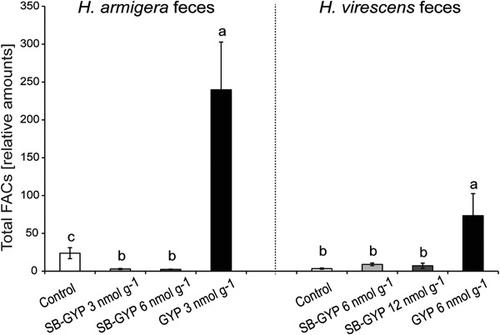当前位置:
X-MOL 学术
›
Arch. Insect Biochem. Physiol.
›
论文详情
Our official English website, www.x-mol.net, welcomes your feedback! (Note: you will need to create a separate account there.)
Consumption of gossypol increases fatty acid-amino acid conjugates in the cotton pests Helicoverpa armigera and Heliothis virescens
Archives of Insect Biochemistry and Physiology ( IF 2.2 ) Pub Date : 2021-09-07 , DOI: 10.1002/arch.21843 Corinna Krempl 1 , Nicole Joußen 1 , Michael Reichelt 2 , Marco Kai 3 , Heiko Vogel 1 , David G Heckel 1
Archives of Insect Biochemistry and Physiology ( IF 2.2 ) Pub Date : 2021-09-07 , DOI: 10.1002/arch.21843 Corinna Krempl 1 , Nicole Joußen 1 , Michael Reichelt 2 , Marco Kai 3 , Heiko Vogel 1 , David G Heckel 1
Affiliation

|
Gossypol is a toxic sesquiterpene dimer produced by cotton plants which deters herbivory by insects and vertebrates. Two highly reactive aldehyde groups contribute to gossypol toxicity by cross-linking herbivore proteins. We identified another consequence of consuming gossypol in two insect pests of cotton: increased amounts of fatty acid-amino acid conjugates (FACs). Eight different FACs in the feces of larval Helicoverpa armigera and Heliothis virescens increased when larvae consumed artificial diet containing gossypol, but not a gossypol derivative lacking free aldehyde groups (SB-gossypol). FACs are produced by joining plant-derived fatty acids with amino acids of insect origin in the larval midgut tissue by an unknown conjugase, and translocated into the gut lumen by an unknown transporter. FACs are hydrolyzed back into fatty acids and amino acids by an aminoacylase (L-ACY-1) in the gut lumen. The equilibrium level of FACs in the lumen is determined by a balance between conjugation and hydrolysis, which may differ among species. When heterologously expressed, L-ACY-1 of H. armigera but not H. virescens was inhibited by gossypol; consistent with the excretion of more FACs in the feces by H. armigera. FACs are known to benefit the plant host by inducing anti-herbivore defensive responses, and have been hypothesized to benefit the herbivore by acting as a surfactant and increasing nitrogen uptake efficiency. Thus in addition to its direct toxic effects, gossypol may negatively impact insect nitrogen uptake efficiency and amplify the signal used by the plant to elicit release of volatile compounds that attract parasitoids.
中文翻译:

棉酚的消耗增加了棉花害虫棉铃虫和黑夜蛾中的脂肪酸-氨基酸结合物
棉酚是一种由棉花植物产生的有毒倍半萜二聚体,可阻止昆虫和脊椎动物的食草。两个高度反应性的醛基通过交联食草动物蛋白质导致棉酚毒性。我们发现了在两种棉花害虫中消耗棉酚的另一个后果:脂肪酸-氨基酸结合物 (FAC) 的数量增加。Helicoverpa armigera和Heliothis virescens幼虫粪便中的八种不同 FAC当幼虫食用含有棉酚的人工饲料时增加,而不是缺乏游离醛基的棉酚衍生物(SB-棉酚)。FAC 是通过未知的结合酶将植物来源的脂肪酸与幼虫中肠组织中昆虫来源的氨基酸连接起来产生的,并通过未知的转运蛋白转运到肠腔中。FAC 被肠腔中的氨酰化酶 (L-ACY-1) 水解回脂肪酸和氨基酸。管腔中 FAC 的平衡水平由结合和水解之间的平衡决定,这可能因物种而异。当异源表达,L-ACY-1的棉铃虫但不H.virescens的由棉酚抑制; 与棉铃虫在粪便中排泄更多 FAC 一致. 已知 FAC 通过诱导抗草食动物防御反应使植物宿主受益,并且已经假设通过充当表面活性剂和提高氮吸收效率使草食动物受益。因此,除了其直接的毒性作用外,棉酚还可能对昆虫的氮吸收效率产生负面影响,并放大植物用来引发释放吸引寄生物的挥发性化合物的信号。
更新日期:2021-10-12
中文翻译:

棉酚的消耗增加了棉花害虫棉铃虫和黑夜蛾中的脂肪酸-氨基酸结合物
棉酚是一种由棉花植物产生的有毒倍半萜二聚体,可阻止昆虫和脊椎动物的食草。两个高度反应性的醛基通过交联食草动物蛋白质导致棉酚毒性。我们发现了在两种棉花害虫中消耗棉酚的另一个后果:脂肪酸-氨基酸结合物 (FAC) 的数量增加。Helicoverpa armigera和Heliothis virescens幼虫粪便中的八种不同 FAC当幼虫食用含有棉酚的人工饲料时增加,而不是缺乏游离醛基的棉酚衍生物(SB-棉酚)。FAC 是通过未知的结合酶将植物来源的脂肪酸与幼虫中肠组织中昆虫来源的氨基酸连接起来产生的,并通过未知的转运蛋白转运到肠腔中。FAC 被肠腔中的氨酰化酶 (L-ACY-1) 水解回脂肪酸和氨基酸。管腔中 FAC 的平衡水平由结合和水解之间的平衡决定,这可能因物种而异。当异源表达,L-ACY-1的棉铃虫但不H.virescens的由棉酚抑制; 与棉铃虫在粪便中排泄更多 FAC 一致. 已知 FAC 通过诱导抗草食动物防御反应使植物宿主受益,并且已经假设通过充当表面活性剂和提高氮吸收效率使草食动物受益。因此,除了其直接的毒性作用外,棉酚还可能对昆虫的氮吸收效率产生负面影响,并放大植物用来引发释放吸引寄生物的挥发性化合物的信号。


























 京公网安备 11010802027423号
京公网安备 11010802027423号